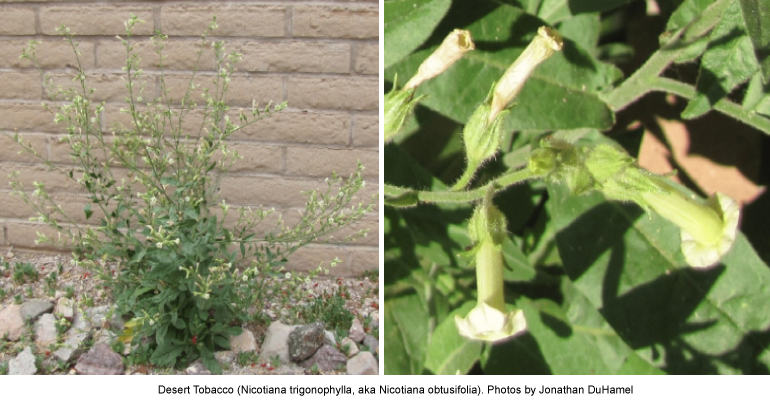
The winter rains have caused many perennial plants to bloom this spring. Among those blooming in my yard is Desert Tobacco (Nicotiana trigonophylla, aka Nicotiana obtusifolia). This bush-like plant gets up to three feet high and blossoms with trumpet-shaped greenish-white to pale yellow flowers. The large leaves are oblong, green, and clasp the stem. The seed capsules contain many small brown seeds. The entire plant is sticky and covered with small hairs.
Desert tobacco can be found throughout the Southwest at elevations below 5,000 feet. It favors disturbed ground and desert washes.
This plant is in the Solanaceae (Nightshade) family, a family which contains some very poisonous plants such as Deadly Nightshade and Sacred Datura. The family also includes potatoes, tomatoes, and chili peppers.
As the scientific name implies, the plant contains nicotine and other alkaloids such as anabasine. These alkaloids can be poisonous in sufficient dosage. The USDA estimates the LD50 dose (lethal to 50% in rats) is 11 mg/kg for anabasine and 50 mg/kg for nicotine. According to An Illustrated Guide to Arizona Weeds, from The University of Arizona Press, the leaves and young stems are the most poisonous parts. Desert Tobacco is poisonous to all kinds of livestock and to humans; cattle and horses are poisoned more often than sheep under normal range conditions. The minimum lethal dose of desert tobacco is about 2 percent of the animal’s weight on a green weight basis.
In spite of the possibly poisonous nature, or maybe because of its qualities, the plant has been used for pleasure, ceremonies, and medicine by native people. According to the National Park Service, leaves were chewed, smoked, or used in a drinkable decoction as part of rituals in many groups, such as to control rain, increase crop production, divining and improving health of community, to drive away malevolent powers. It was smoked by travelers to clear away all danger and ensure blessing from spiritual guides. A poultice was applied to cuts, bruises, swellings and other wounds. An infusion was used as an emetic. Leaf smoke blown into the ear and covered with a warm pad treated earaches.
I’ve seen this plant promoted by nurseries as a landscaping option. As the seed pods develop, you may see the plants covered with small dark bugs in the family Thyreocoridae. They feed on the developing seeds.
See more articles about desert plants on ADI:
Agaves provide food, fiber and adult beverages
Cactus water will make you sick
Chiltepin peppers, spice and medicine
Invasion of the Popcorn Flowers
Joshua Trees of the Mohave Desert
Medusa’s Head a strange and useful plant
Mesquite trees provide food, fuel, medicine, and more
Oak trees of the Sonoran Desert region
Ocotillo – an aide to hummingbirds and geologists
Palo Verde trees about to turn the desert golden
Saguaro Cactus Icon of the Sonoran Desert
Spectacular flowers of the red Torch Cactus
